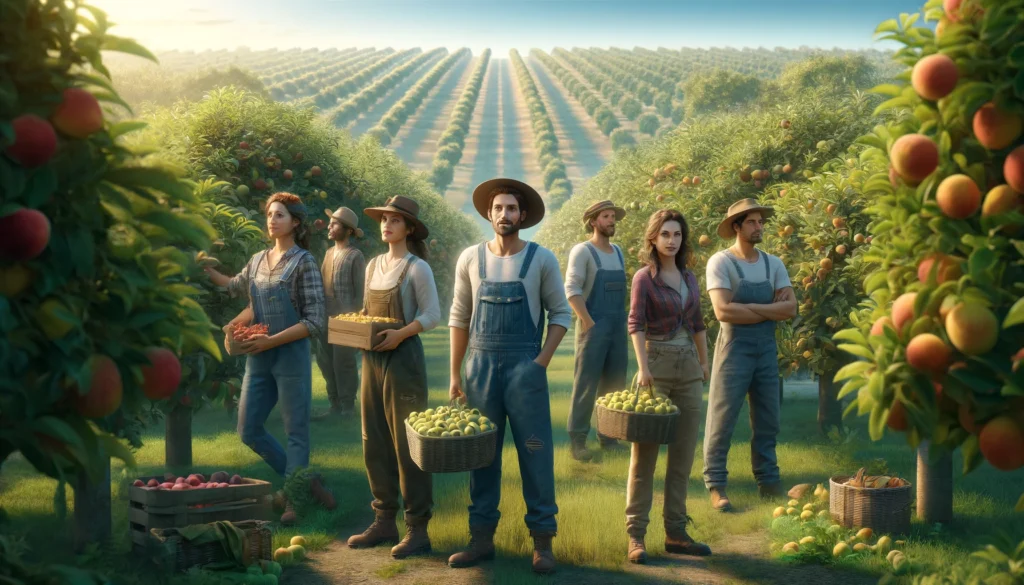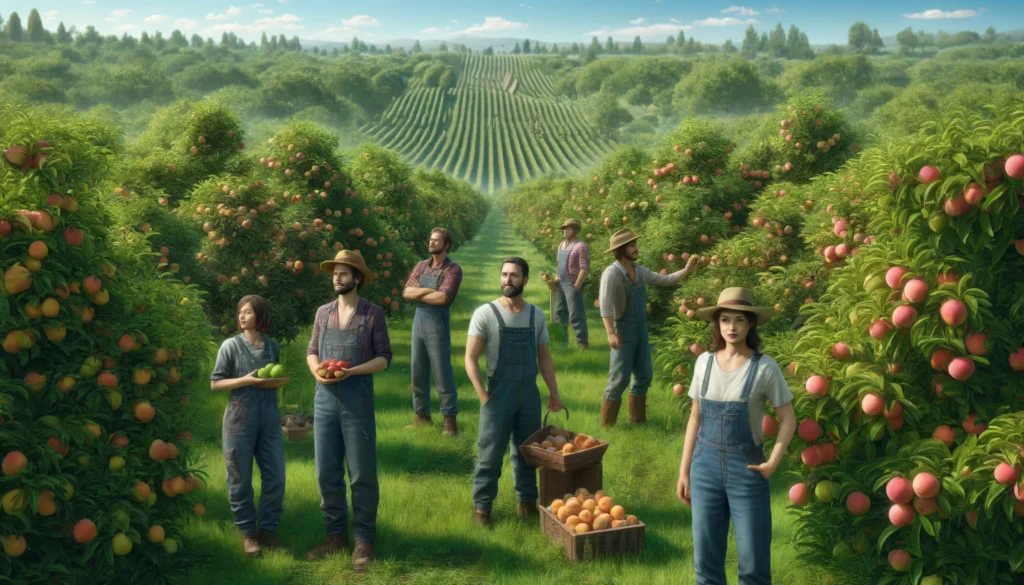
Comprehensive Guide for Fruit Orchard Farmers
Fruit orchard farming can be both rewarding and challenging. Successful orchard management requires careful planning, regular maintenance, and informed decision-making. This comprehensive guide will provide tips, expert advice, cost-effective solutions, money-saving hacks, budget-friendly options, and insider secrets to help you optimize your fruit orchard operations.
Planning Your Fruit Orchard
Choosing the Right Location
- Climate Considerations: Select a location with a climate that suits the types of fruits you plan to grow. Some fruits thrive in temperate climates, while others require subtropical or tropical conditions.
- Soil Quality: Test the soil for pH, nutrient content, and drainage capacity. Ideal orchard soil is loamy, well-drained, and rich in organic matter.
- Water Availability: Ensure a reliable water source for irrigation. Consider rainfall patterns and proximity to rivers or wells.
- Sunlight Exposure: Choose a site with full sun exposure. Most fruit trees need at least 6-8 hours of direct sunlight daily.
Selecting Fruit Varieties
- Market Demand: Research local and regional market demand to select fruit varieties with high selling potential.
- Pollination Requirements: Some fruit trees require cross-pollination. Plant compatible varieties close to each other to ensure effective pollination.
- Disease Resistance: Choose fruit varieties known for their resistance to common diseases in your area.
- Harvest Timing: Plan for a staggered harvest by selecting varieties that ripen at different times, ensuring a continuous supply of fresh produce.
Designing the Orchard Layout
- Tree Spacing: Space trees appropriately to ensure adequate sunlight, air circulation, and room for growth. Overcrowded orchards can lead to increased disease pressure.
- Row Orientation: Plant rows in a north-south orientation to maximize sunlight exposure.
- Irrigation Infrastructure: Plan for efficient irrigation systems, such as drip or micro-sprinkler systems, to conserve water and reduce costs.
- Windbreaks: Install windbreaks, such as hedges or fences, to protect young trees from strong winds.

Planting and Establishing the Orchard
Soil Preparation
- Soil Testing: Conduct soil tests to determine nutrient levels and pH. Amend the soil based on test results to create optimal growing conditions.
- Organic Matter: Incorporate compost or well-rotted manure to improve soil structure and fertility.
- Weed Control: Remove weeds and grasses from the planting area to reduce competition for nutrients and water.
Planting Techniques
- Planting Time: Plant fruit trees during the dormant season (late fall or early spring) to minimize transplant shock.
- Hole Preparation: Dig planting holes twice as wide and slightly deeper than the root ball. This encourages root spread and establishment.
- Planting Depth: Position the tree so that the graft union is above the soil line. Planting too deep can lead to root rot.
- Watering: Water newly planted trees thoroughly to settle the soil around the roots and eliminate air pockets.
Mulching
- Mulch Material: Use organic mulch, such as straw, wood chips, or bark, to retain moisture, suppress weeds, and improve soil health.
- Mulch Depth: Apply a 2-4 inch layer of mulch around the base of each tree, keeping it away from the trunk to prevent rot.
- Replenishing Mulch: Reapply mulch as needed to maintain a consistent layer and continue reaping its benefits.

Orchard Management and Maintenance
Pruning
- Pruning Objectives: Prune fruit trees to remove dead or diseased wood, improve air circulation, and shape the tree for better light penetration.
- Pruning Timing: Perform major pruning during the dormant season and light pruning during the growing season to remove suckers and water sprouts.
- Tools and Techniques: Use sharp, clean tools to make clean cuts. Make cuts just above a bud or branch junction to promote healthy growth.
Irrigation
- Irrigation Scheduling: Water trees deeply and infrequently to encourage deep root growth. Adjust irrigation based on weather conditions and soil moisture levels.
- Water Conservation: Use drip irrigation or micro-sprinklers to deliver water directly to the root zone, reducing evaporation and runoff.
- Monitoring: Regularly check irrigation systems for leaks or clogs and ensure uniform water distribution.
Fertilization
- Nutrient Requirements: Provide balanced fertilizers based on soil test results and the specific nutrient needs of your fruit trees.
- Application Timing: Apply fertilizers in early spring and mid-summer to support tree growth and fruit development.
- Organic Options: Consider using organic fertilizers, such as compost, fish emulsion, or bone meal, to enhance soil health and sustainability.
Pest and Disease Management
- Integrated Pest Management (IPM): Implement an IPM approach that combines biological, cultural, mechanical, and chemical control methods.
- Monitoring: Regularly inspect trees for signs of pests and diseases. Use traps, pheromones, and visual checks to monitor pest populations.
- Biological Controls: Encourage beneficial insects, such as ladybugs and predatory wasps, to naturally control pest populations.
- Cultural Practices: Practice good orchard hygiene, such as removing fallen fruit and pruning infected branches, to reduce disease pressure.

Harvesting and Post-Harvest Handling
Harvest Timing
- Maturity Indicators: Harvest fruit at the optimal stage of ripeness based on color, size, firmness, and taste.
- Sequential Harvesting: Pick fruit in multiple passes as it ripens, rather than all at once, to ensure peak quality.
Harvesting Techniques
- Hand Harvesting: Use gentle hand-picking methods to avoid bruising and damage. Wear gloves to protect both the fruit and your hands.
- Mechanical Harvesting: Consider mechanical harvesters for large orchards, but ensure proper calibration to minimize fruit damage.
Post-Harvest Handling
- Sorting and Grading: Sort fruit by size, color, and quality. Remove damaged or diseased fruit to prevent spoilage.
- Cooling: Promptly cool harvested fruit to slow down respiration and extend shelf life. Use cool storage or refrigeration units.
- Packaging: Use appropriate packaging materials, such as crates or boxes, to protect fruit during transport and storage.

Cost-Effective Solutions and Money-Saving Hacks
Efficient Irrigation Systems
- Drip Irrigation: Install drip irrigation systems to save water and reduce labor costs. These systems deliver water directly to the root zone with minimal waste.
- Rainwater Harvesting: Collect and store rainwater for irrigation. This reduces reliance on municipal water sources and lowers utility bills.
Energy Savings
- Solar Power: Invest in solar panels to power irrigation systems, cold storage units, and other orchard equipment. This reduces energy costs and environmental impact.
- Energy-Efficient Equipment: Use energy-efficient pumps, lighting, and refrigeration units to lower electricity consumption.
Labor Optimization
- Seasonal Workers: Hire seasonal workers during peak periods, such as planting and harvesting, to reduce labor costs.
- Training Programs: Train workers in efficient pruning, harvesting, and packing techniques to improve productivity and reduce waste.
Soil Health Management
- Cover Crops: Plant cover crops, such as clover or vetch, to improve soil fertility, reduce erosion, and suppress weeds. This reduces the need for chemical fertilizers and herbicides.
- Composting: Create on-site compost from orchard waste, such as pruned branches and fallen leaves. This provides a cost-effective source of organic fertilizer.
Disease and Pest Control
- Organic Sprays: Use homemade or low-cost organic sprays, such as neem oil or insecticidal soap, to manage pests and diseases.
- Crop Rotation: Rotate crops within the orchard to reduce pest and disease buildup in the soil.

Budget-Friendly Options and Insider Secrets
DIY Solutions
- Homemade Fertilizers: Create DIY fertilizers using household waste, such as eggshells (for calcium) and coffee grounds (for nitrogen).
- Natural Pesticides: Make natural pesticides using ingredients like garlic, chili peppers, and soap to control pests without expensive chemicals.
Collaborative Efforts
- Cooperatives: Join or form a farming cooperative to share resources, such as equipment and labor, and reduce individual costs.
- Knowledge Sharing: Network with other farmers to share tips, techniques, and solutions for common challenges.
Grants and Subsidies
- Government Programs: Apply for agricultural grants and subsidies offered by government agencies to support orchard development and sustainability initiatives.
- Research Grants: Partner with universities or research institutions to access funding for innovative projects and trials.
Market Diversification
- Value-Added Products: Process fruits into value-added products, such as jams, juices, and dried fruit, to increase revenue streams.
- Agri-Tourism: Offer farm tours, pick-your-own fruit experiences, and educational workshops to attract visitors and generate additional income.
Innovative Practices
- Precision Agriculture: Use precision agriculture technologies, such as GPS and drones, to monitor orchard conditions and optimize inputs like water and fertilizers.
- Biochar: Incorporate biochar into the soil to improve fertility, water retention, and carbon sequestration.

Practical Tips for Successful Orchard Management
Regular Monitoring
- Weekly Inspections: Conduct weekly inspections of trees for signs of pests, diseases, and nutrient deficiencies.
- Record Keeping: Maintain detailed records of orchard activities, including planting dates, pruning schedules, and pesticide applications.
Balanced Fertilization
- Soil Amendments: Regularly test soil and amend it with lime or sulfur to maintain optimal pH levels.
- Foliar Feeding: Apply foliar fertilizers during the growing season to quickly address nutrient deficiencies.
Water Management
- Soil Moisture Monitoring: Use soil moisture sensors to track soil moisture levels and adjust irrigation schedules accordingly.
- Water-Saving Techniques: Implement water-saving techniques, such as mulching and drip irrigation, to conserve water.
Disease Prevention
- Sanitation: Keep the orchard clean by removing fallen fruit and pruning debris to reduce disease pressure.
- Resistant Varieties: Plant disease-resistant varieties to minimize the need for chemical treatments.
Efficient Harvesting
- Harvesting Aids: Use harvesting aids, such as picking ladders and baskets, to improve efficiency and reduce fruit damage.
- Post-Harvest Handling: Handle fruit carefully during harvesting and packing to maintain quality and extend shelf life.

Expert Advice for Fruit Orchard Farmers
Pest and Disease Management
- Scouting Programs: Establish a regular scouting program to identify pest and disease issues early. Train workers to recognize symptoms and report findings.
- Biological Controls: Integrate biological controls, such as beneficial insects and natural predators, into your pest management strategy.
Pruning Techniques
- Training Systems: Use training systems, such as open center or central leader, to shape trees for optimal sunlight exposure and air circulation.
- Pruning Tools: Invest in high-quality pruning tools and maintain them regularly to ensure clean cuts and reduce disease spread.
Soil Fertility
- Soil Testing: Conduct annual soil tests to monitor nutrient levels and adjust fertilization programs accordingly.
- Organic Matter: Increase soil organic matter through cover cropping, composting, and mulching to improve soil health and structure.
Irrigation Management
- Drip Irrigation: Implement drip irrigation systems to deliver water directly to the root zone, reducing water waste and improving efficiency.
- Water Conservation: Use water conservation techniques, such as mulching and rainwater harvesting, to reduce irrigation needs and save costs.
Marketing Strategies
- Direct Sales: Sell directly to consumers through farmers’ markets, CSA programs, and farm stands to increase profit margins.
- Value-Added Products: Diversify income streams by producing value-added products, such as jams, jellies, and dried fruits.
Insider Secrets for Fruit Orchard Farmers
Enhancing Fruit Quality
- Thinning: Thin excess fruit to improve size, quality, and flavor. This also reduces stress on the tree and prevents limb breakage.
- Girdling: Use girdling techniques to enhance fruit size and sweetness. Carefully remove a strip of bark around the trunk to temporarily reduce carbohydrate transport and stimulate fruit growth.
Extending Harvest Season
- Variety Selection: Plant a mix of early, mid, and late-season varieties to extend the harvest period and ensure a continuous supply of fresh fruit.
- Staggered Planting: Stagger planting dates for different varieties to spread out the harvest and avoid market gluts.
Cost-Saving Measures
- Bulk Purchasing: Buy supplies, such as fertilizers and pesticides, in bulk to take advantage of discounts and reduce costs.
- Second-Hand Equipment: Consider purchasing second-hand equipment, such as tractors and sprayers, to save money while maintaining functionality.
Labor Management
- Efficient Labor Use: Schedule labor-intensive tasks, such as pruning and harvesting, during cooler parts of the day to improve worker productivity and comfort.
- Seasonal Workers: Hire seasonal workers for peak periods to reduce labor costs and ensure timely completion of tasks.
Soil Health Practices
- Cover Cropping: Use cover crops to improve soil fertility, structure, and water retention. Cover crops also suppress weeds and reduce erosion.
- Composting: Incorporate compost into the soil to provide a slow-release source of nutrients and improve soil health.
Practical Examples and Case Studies
Case Study 1: Sustainable Orchard Management
Location: Green Valley Orchard, France
Practices:
- Soil Health: Green Valley Orchard uses cover crops and compost to improve soil fertility and structure. Annual soil tests guide their fertilization program.
- Pest Management: The orchard employs an integrated pest management (IPM) approach, using beneficial insects and natural predators to control pests. Regular scouting helps identify issues early.
- Water Conservation: Drip irrigation and rainwater harvesting reduce water use and costs. Mulching helps retain soil moisture and suppress weeds.
- Marketing: Green Valley Orchard sells directly to consumers through a CSA program and farmers’ markets. They also produce value-added products, such as apple cider and dried fruit.
Outcomes: Green Valley Orchard has achieved high fruit quality, reduced input costs, and increased profitability through sustainable practices.
Case Study 2: Innovative Irrigation Solutions
Location: Sunshine Orchards, Spain
Practices:
- Water-Saving Techniques: Sunshine Orchards implemented a precision drip irrigation system, reducing water use by 30%. Soil moisture sensors help optimize irrigation schedules.
- Rainwater Harvesting: The orchard collects and stores rainwater for irrigation, reducing reliance on municipal water sources and lowering utility bills.
- Energy Efficiency: Solar panels power the irrigation system and cold storage units, reducing energy costs.
Outcomes: Sunshine Orchards has significantly reduced water and energy costs while maintaining high fruit quality and yield.
Case Study 3: Organic Orchard Management
Location: Eco-Fruit Farms, Germany
Practices:
- Organic Fertilizers: Eco-Fruit Farms uses compost, fish emulsion, and bone meal to provide nutrients. Soil tests guide their fertilization program.
- Natural Pest Control: The orchard uses neem oil, insecticidal soap, and beneficial insects to manage pests. Crop rotation and cover crops reduce disease pressure.
- Sustainable Practices: Eco-Fruit Farms practices crop rotation, cover cropping, and mulching to improve soil health and reduce erosion.
Outcomes: Eco-Fruit Farms has achieved organic certification, reduced input costs, and increased market demand for their organic fruit.
Conclusion
Successful fruit orchard management requires careful planning, regular maintenance, and informed decision-making. By implementing the tips, expert advice, cost-effective solutions, money-saving hacks, budget-friendly options, and insider secrets outlined in this guide, fruit orchard farmers can optimize their operations, enhance productivity, and increase profitability. Remember to stay informed, adapt to changing conditions, and continuously seek innovative practices to ensure long-term success in your orchard farming endeavors.